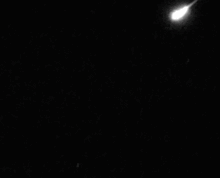十月天龍座流星雨
外观
(重定向自天龍座流星雨)

十月天龍座流星雨,過去曾非正式稱為賈可比尼流星雨(Giacobinids,舊譯為加克敏流星雨,省略號 GIA),因為它的母彗星是21P/賈可比尼-秦諾彗星 [1]。在2006年8月捷克首都布拉格的國際天文聯會大會上,決定不使用彗星名字來命名流星雨[2]。這個流星雨因為輻射點在天龍座,所以稱為「天龍座流星雨」(省略號 DRA)。為免混亂,國際天文聯會2009年8月7日,在巴西里約熱內盧的大會中,將原本在一月份出現的「天龍座流星雨」用「象限儀座流星雨」替代。問題是目前共有41個流星雨,它們的輻射點都是位於天龍座,因此再將這個十月份出現的「天龍座流星雨」更改為「十月天龍座流星雨」[3]October Draconids,但仍舊保留 DRA 這個省略號[4],以顯示變化的來源。
這個流星雨出現在每年的10月初,最佳的觀測日期在10月7日至9日,而最佳的觀測時間則是天剛黑的數小時內,選擇天空乾淨且黑暗無光害的場所[5]。在1933年[6][7]和1946年 [7]的天龍座流星雨曾有高達每小時數千顆流星的天頂每時出現率。罕見的爆發可能是地球穿越了彗星殘骸碎片密集處造成的,例如在1998年,流星數量也曾突然飆升[8][9],在2005年也再次飆升(極引人注目)[10]。 十月天龍座流星雨的爆發[11]如預期的[12][13][14]在2011年10月8日發生,但炫目的上弦月使目視的流星數量銳減。在2012年的雷達觀測,也測到每小時超過1000顆的流星。2012年的爆發,可能是母彗星在1959年遺留的狹窄灰塵和岩屑造成的[15]。
相關條目
[编辑]參考資料
[编辑]- ^ [1][永久失效連結] 譯名出自《科學月刊 192期 外太空的第三類接觸,作者:何丹曦‧劉康克》
- ^ Peter Jenniskens, The IAU Meteor Shower Nomenclature Rules WGN, Journal of the International Meteor Organization, Vol. 34-5, p. 127-128, 2006.
- ^ 香港天文學會智能手提電話應用程式《香港天文》2018年天象報導,余惠俊主編
- ^ IAU Meteor Data Center Meteor Number 00009
- ^ Meteor Activity Outlook for October 6-12, 2012. [2012-10-08]. (原始内容存档于2013-06-22).
- ^ John McFarland and Mark Bailey. Account of the 1933 Draconids meteor storm. International Meteor Organization (IMO). October 7, 2011 [2011-10-08]. (原始内容存档于2011-10-10).
- ^ 7.0 7.1 Kronk, Gary W. Meteor Showers Online. [2011-12-06]. (原始内容存档于2008-08-07).
- ^ Giacobinids dazzle observers. October 14, 1998 [2016-10-19]. (原始内容存档于1999-02-20).
- ^ Arlt, R. "Summary of 1998 Draconid Outburst Observations" (页面存档备份,存于互联网档案馆), WGN, Journal of the International Meteor Organization, Vol. 26, p. 256-259, 1998.
- ^ Campbell-Brown, M.; Vaubaillon, J.; Brown, P.; Weryk, R. J.; Arlt, R. "The 2005 Draconid outburst" (页面存档备份,存于互联网档案馆), Astronomy and Astrophysics, Volume 451, pp.339-344, 2006.
- ^ Draconids show expected outburst. International Meteor Organization (IMO). [2011-12-06]. (原始内容存档于2011-12-13).
- ^ Adrian West. The Draconid Meteor Shower – A Storm is Coming!. Universe Today. October 3, 2011 [2011-10-03]. (原始内容存档于2011-10-05).
Observers in the UK and Northern Europe are ideally placed to see the peak of the Draconids. Unfortunately the peak occurs in the day time for North America. There will also be a bright Moon which may drown out many but the brightest meteors, but if predictions are correct, you will still see many. You may see Draconid meteors on the 7th an the 9th also, so it is worth going out and checking the skies.
- ^ Draconids Meteor Shower on 8 October 2011. International Meteor Organization. [2016年10月19日]. (原始内容存档于2011年9月25日).
- ^ Beatty, Kelly. A Deluge of Draconids?. Sky and Telescope. Highlights. [31 December 2010]. (原始内容存档于2012-10-25).
- ^ Geert Barentsen. Draconids show outburst (again!). 2012-10-08 [2012-10-08]. (原始内容存档于2016-03-13).
- Michael D. Reynolds. Falling Stars. Stackpole Books, 2001. p. 42.
- Jun-Ichi Watanabe and Mikiya Sato. "Activities of Parent Comets and Related Meteor Showers"[永久失效連結]. Earth, Moon, and Planets, Vol 102, No 1-4 (June 2008). p111-116.
- Draconids 2011 ephemerides
外部連結
[编辑]- Draconid Meteors Over Spain (页面存档备份,存于互联网档案馆) (Astronomy Picture of the Day 2011 October 19)
- The 2012 Draconid Storm Potentially Sampled By NASA ER-2 Aircraft(页面存档备份,存于互联网档案馆) (item 12)

